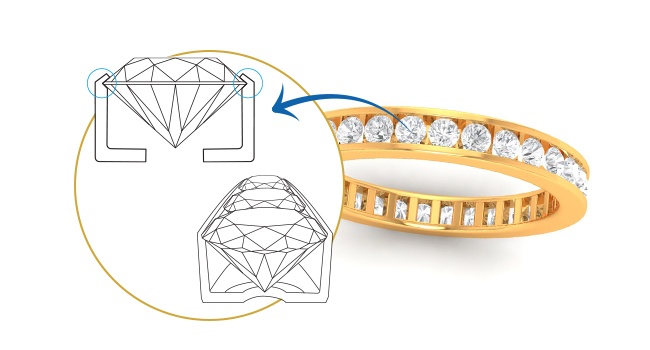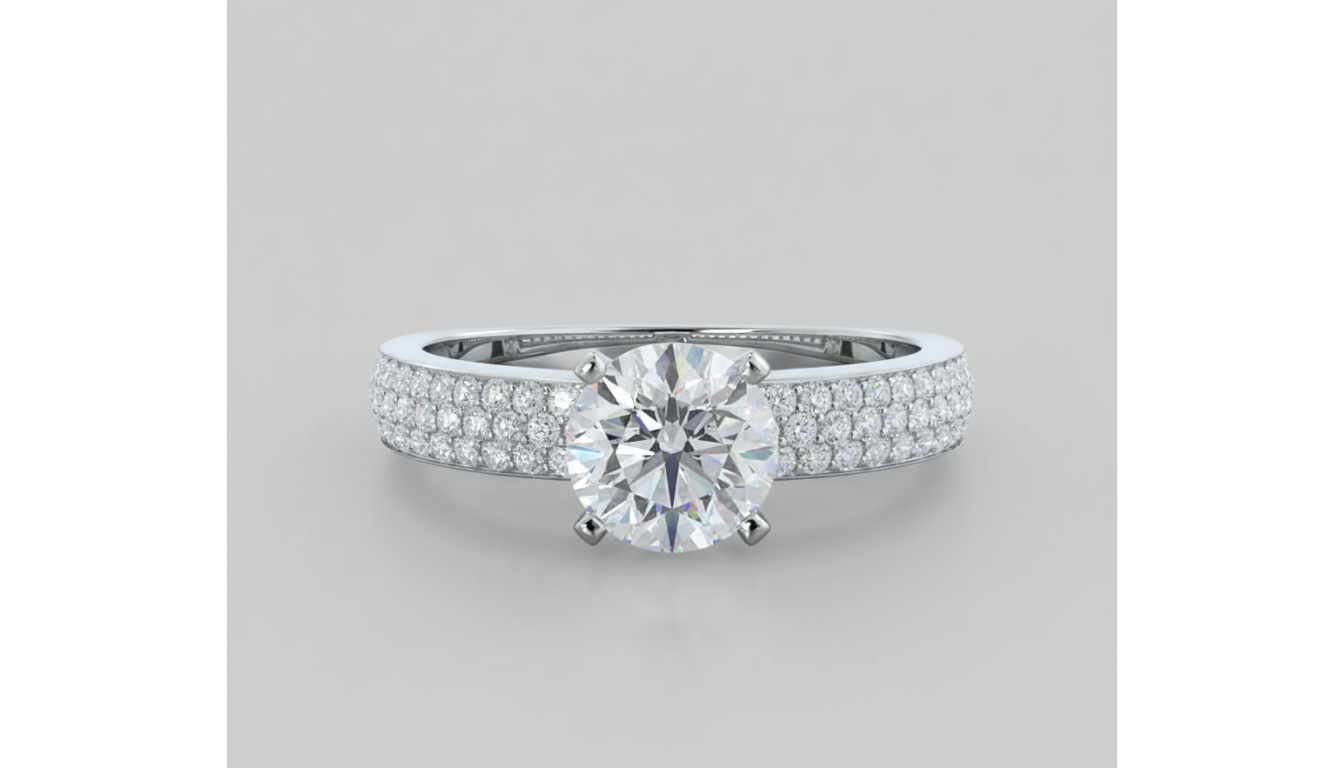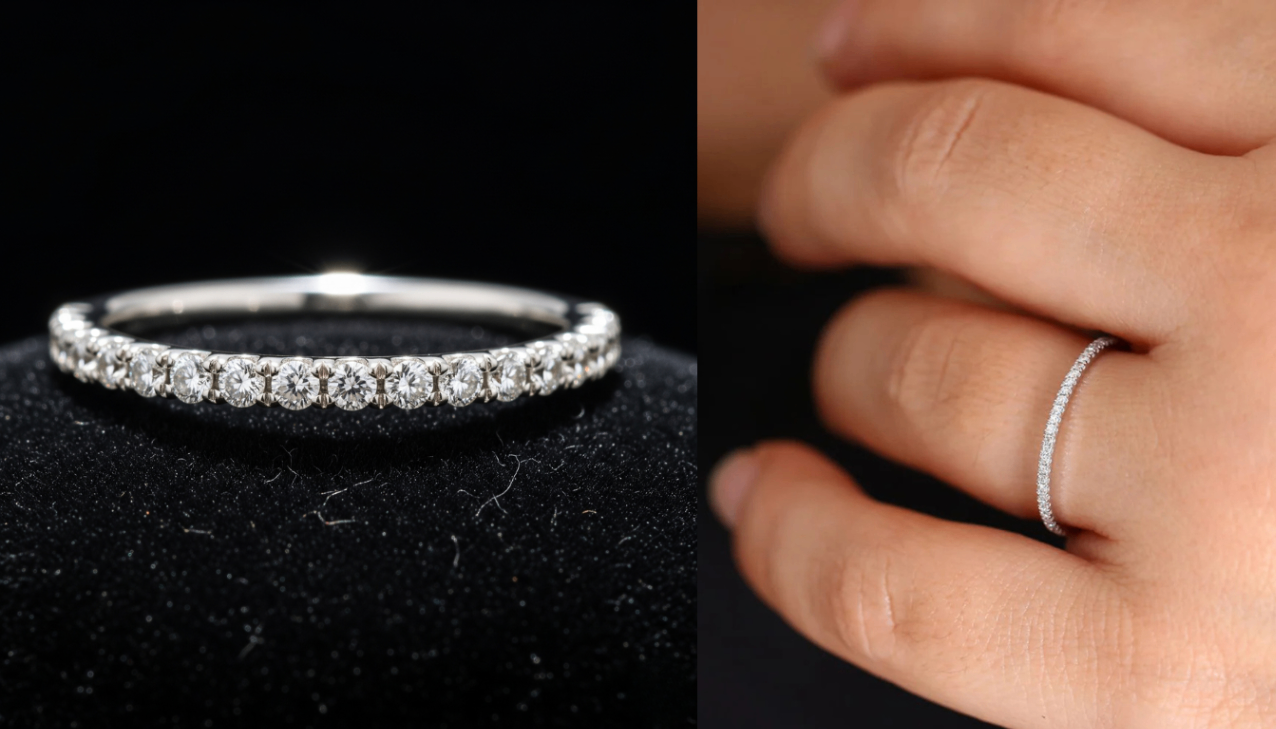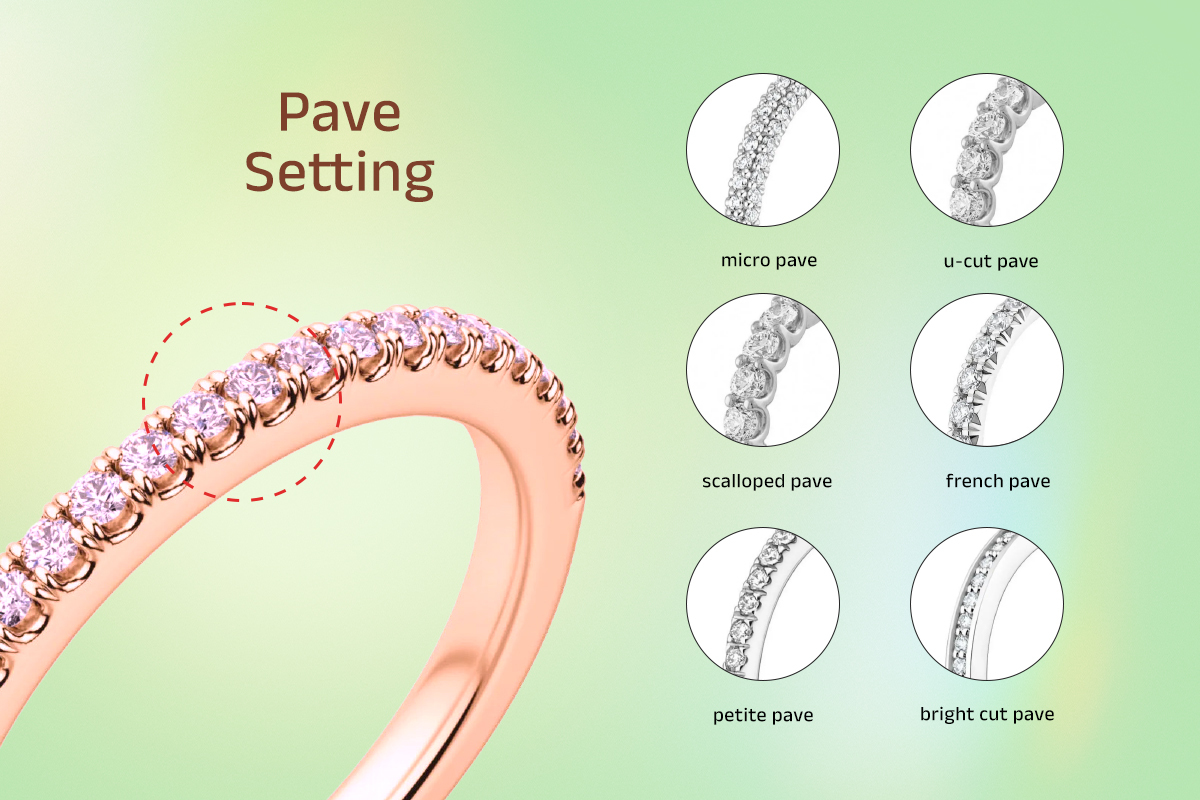What is a Pavé Setting Ring? Learn Types and Meanings
When you’re exploring engagement rings or fine jewelry, one term you’ll encounter again and again is the pavé setting. These settings originated in Europe but are now popular all around the world. And if you are in the path of buying a diamond ring and want to add something that looks fabulous and shiny with a solitaire, but don’t want a halo setting or three stone setting, the pavé setting is just your right choice! But despite its popularity, many online explanations oversimplify how pavé is made, overlook the differences between true pavé styles, or skip essential details about durability and maintenance.
This guide gives you a clear, accurate, and easy-to-understand explanation of what a pavé setting really is, without the misconceptions. You’ll learn how pavé is crafted, the most widely recognized types used by expert jewelers, how to spot quality workmanship, and what to consider for long-term wear and care. Whether you’re choosing an engagement ring or simply learning about fine jewelry design, this article will help you make an informed, confident choice.
What is a Pave Setting?
The term “pave,” pronounced “pa-vay,” originates from the French word for “paving” or “paved,” and it describes a particular setting technique characterized by a continuous array of small diamonds set closely together in tiny holes drilled into the metal covering the surface of the band, much like a paved road.
This technique is known for its dazzling sparkle, showcasing the beauty of a continuous band of diamonds that adds to the overall brilliance of the jewelry piece.
This setting can be further refined into variations such as the bead setting or micro-pavé, where even smaller diamonds, typically less than 0.01 carats, are secured with tiny prongs that hold the stones in place.
This setting minimizes visible metal and maximizes brilliance, making it a popular choice for engagement rings, wedding bands, and fine jewelry with a refined, elegant shine. And Pavé band made in two types half pave or full pave. If you want more shine you can get full pave and if you want minimalist shine you can opt half pave.
Types of Pavé Bands: Full Pavé and Half Pavé
Pavé diamond bands come in two popular styles; full pavé and half pavé, each offering its own balance of sparkle, durability, and everyday comfort. Understanding the difference between these two pavé band types helps you choose the perfect ring design, whether you want maximum brilliance or a more practical, wear-friendly option.
What is the Difference Between and Full Pave and a Half Pave Band
- Full Pavé Setting features diamonds set all the way around the ring’s band, creating a complete 360-degree circle of sparkle. Because the diamonds encircle the entire shank, there is no visible plain metal, giving the ring a luxurious, uninterrupted brilliance.
- Half Pavé Setting features diamonds that cover only the front or upper portion of the ring’s band, usually the top 40-60%. The underside of the ring remains plain metal, offering comfort and practicality while still showcasing the beauty of pavé.
Understanding the distinction between full pavé and half pavé bands enhances the selection process for engagement and wedding rings. A full pavé band is adorned with tiny diamonds or smaller gemstones encircling the entire circumference, maximizing brilliance and creating a seamless sparkle, giving a luxurious feel. In contrast, a half pavé band features the setting style only on one half, showcasing the center stone while allowing for a clearer view of the band’s metalwork, and is more comfortable for the daily hustle. This choice reflects different preferences in aesthetics and durability, impacting overall design.
10 Most Widely Recognized Pave Settings Used by Expert Jewelers
These are the top 10 types of pave setting in jewelry. You can choose one that matches your aesthetic. Otherwise, there are plenty of options available that jewelry makers implement based on the diamond cut and design of jewelry.
Micro pave set

A Micro pave set is a style of pave setting where the diamonds are placed in a very tight formation. A micro pave setting has a lot of potential because you have more room to play with the placement of the diamonds. This means you can make them look really cool by placing them in different positions.
The downside of this setting is that the diamonds will not sit and flow against each other. They will be slightly spaced apart from each other. This creates a gap between the diamonds. If you want to fill up the space between the diamonds, you can use a bond-like sealant to secure the stones together. The advantage of using a micro pave setting is that the diamonds are extremely close together. This makes it easier to see the light refracting off the diamonds. When
French Pave

This is a great setting if you like having lots of diamonds on your ring. It looks especially good when there are many diamonds in a single row. It also looks nice when the diamonds are arranged in a circle, less metal is used to cover the diamonds, and more is left uncovered.
Another thing about this set is that the stones are usually bigger than those found in a micro pave setting. This gives the stone an even more dramatic appearance.
U-cut Pave or Scallop

A U-cut pave setting is similar to a French pave setting. However, instead of being a circle, the diamonds are arranged in an oval shape with U-shaped grooves. This gives the stone a unique look, and it adds some interest to the overall design of the ring. It adds a specific design of metal rings. If you prefer a traditional look, then a U-cut pave setting may be just what you need.
Bright Cut Channel Pave

It is a type of vintage pavé setting that was designed to help create a beautiful diamond pattern. The bright cut channel is the most traditional setting. It is one of the most popular styles of pavé setting. Bright-cut channels are made out of gold or silver. They were created so that the light would reflect off the diamonds. The result is a very pretty-looking piece of jewelry.
Shared Prong Pave

It is a setting where two rows of diamonds are placed next to each other. The first row is positioned above the second row. The top row sits directly over the bottom row. The shared prong setting is a relatively new style of pavé setting. It allows you to use as much or as little metal as you want. This means that you can get a fancy-looking ring without spending a lot of money. The downside to this setting is that it takes a long time to make. It gives an invariant look to the metal.
Surface Prong Pave

In the surface prong, each diamond is held tightly by a tiny metal. They can be rounded or flat. They are commonly used with large diamonds. In the surface prong, each stone is firmly attached to the setting by a small “prong”.
Bar Pave Setting

The bar pave setting is a distinctive style that features small holes or bars of metal that securely hold the diamonds in place. This design often uses baguette-cut diamonds, allowing for a sleek and modern appearance. Bar settings are particularly favored for their ability to enhance the diamond’s light reflection, creating a striking visual effect.
While the small holes provide a unique aesthetic, they also require skilled setters to ensure the diamonds are precisely aligned and securely held. Regular maintenance is key, as the integrity of the bars can impact the overall durability of the piece. Bar pave settings are an excellent choice for those looking for a contemporary twist on traditional pave designs.
Bezel Pave Setting

The bezel pavé setting is characterized by medium sized diamonds set in continuse row as normal paved, but each diamond is enclosed by a metal rim. This setting showcase a vintage style, a diamond which are very small in sizes are not possible to set bezel setting in pave, as this setting is not made for pave, but people still add bezel to their band for more vintage and art deco asthetics. In bezel pave, each diamond paved separately in metal.
Multi-row/Double Pavé

Multi-row or double pavé settings are an exquisite choice for jewelry lovers seeking added sparkle and dimension. This style features multiple rows of smaller gemstones with their precise facets, creating a stunning visual effect that enhances the overall brilliance of the piece. The arrangement of smaller gemstones not only increases the ring’s shine but also showcases the craftsmanship involved in creating a seamless look. Multi-row pavé settings are often seen in rings, bracelets, and necklaces, making them a versatile addition to any jewelry collection.
Petite Pavé

Similar to traditional pavé but uses extremely small prongs, making diamonds look more prominent. These settings are designed with tiny diamonds that create a delicate and sparkling effect. The use of smaller gemstones and small stones allows for a more minimal design, enhancing the overall brilliance of the piece without overwhelming the center stone. This style is perfect for a stackable band, complementing the main solitaire ring. Whether in engagement rings or other jewelry, petite pavé settings are an excellent choice for a refined, timeless look.
Design-House Variations
The world of pavé settings has evolved significantly, leading to unique and modern variations that cater to diverse tastes. From vintage-inspired designs to contemporary styles, there is a pavé setting for everyone. For example, the cut-down pavé, known for its elegant arches and intricate craftsmanship, reflects the artistry involved in modern jewelry making. Additionally, designs like mushroom pavé provide a whimsical touch, showcasing small diamonds arranged in a delicate pattern for a stunning visual effect. These variations not only enhance the aesthetics of the jewelry but also offer personalization options to suit individual styles.
With these modern takes on pavé settings, jewelry enthusiasts can find pieces that resonate with their personal tastes while still enjoying the timeless beauty of this enchanting setting style. Whether you prefer a classic look or something more avant-garde, the options are limitless, ensuring that every piece stands out in its own right.
Cut-Down Pavé (Neo-French)
Cut-down pavé, often referred to as Neo-French, is a modern adaptation of traditional pave techniques. This setting style features small arches and vertical slits around the stones, creating a unique visual effect while allowing for increased light exposure. The meticulous craftsmanship involved in cut-down pavé is a testament to the skill of the jeweler, as it requires precision to ensure that each diamond is perfectly aligned. This setting not only enhances the brilliance of the stones but also provides a vintage charm that appeals to many. The combination of modern aesthetics with classic techniques makes cut-down pavé a popular choice for those seeking a standout piece that bridges the gap between traditional and contemporary styles.
Mushroom Pavé
Mushroom pavé is an innovative and eye-catching setting technique characterized by its delicate arrangement of small diamonds. This style features diamonds set in a single file along narrow strips of metal, creating a unique “mushroom” effect that appears almost suspended in mid-air. The diamonds are closely packed to maximize their brilliance, allowing for a stunning display of sparkle. Mushroom pavé not only elevates the visual appeal of the jewelry but also enhances its durability, making it a favorite among those who appreciate both beauty and practicality. This setting style is perfect for adding a touch of whimsy and elegance to any piece, whether it’s a ring, pendant, or bracelet.
Random Pavé
Random pavé is a creative and artistic approach to gemstone setting, allowing for a mix of diamond sizes arranged in an unpredictable yet harmonious manner. This setting style mimics the beauty of nature, with the varying diamond sizes creating a sense of organic flow. The randomness of the arrangement enhances the overall design, making each piece unique and one-of-a-kind. This technique not only showcases the beauty of individual gemstones but also allows for greater design flexibility, appealing to those who seek distinctive and unconventional jewelry. Random pavé is perfect for anyone looking to make a statement with their jewelry, offering an artistic flair that stands out.
Royal/Six-bead Pavé
Royal or six-bead pavé is a classic setting style that combines elegance with durability. In this design, each diamond is supported by six tiny prongs, forming a honeycomb pattern that enhances the overall sparkle of the piece. The distinctive six-bead construction provides added security for the stones, making this setting ideal for wedding bands and engagement rings that are meant to withstand everyday wear. The royal pavé setting not only highlights the brilliance of the diamonds but also offers a timeless look that appeals to both traditional and modern tastes. This setting style is perfect for those seeking a blend of sophistication and durability in their jewelry.
Pros of Getting a Pave Setting
The pave setting is a great way to enhance your existing jewelry. When you buy a pave setting, you will not only increase the value of your current jewelry, but you will also get a more fashionable look. A pave setting looks amazing on any kind of jewelry. Whether you are looking at a necklace, earrings, bracelet, or even a ring, a pavé setting will work perfectly.
A paved setting is a great investment because it will last forever. Many people think that paved settings are expensive. But when you consider how many years you will wear your piece of jewelry, then it makes sense to invest in a pavé setting.
Pave Stone Setting Process
Here’s a friendly, step-by-step guide to how pavé stone setting comes together:
- Picking Perfect Stones: It all begins with selecting tiny diamonds or gemstones that look alike in size and shine. The goal is a smooth, sparkling effect with every little stone shining in harmony, as professional setters would ensure the perfect placement during the setting process.
- Planning the Pattern: The jeweller maps out where each stone will sit on the metal. This careful marking helps make sure every gem is placed just right.
- Making Cozy Seats: Small holes are drilled where each stone will go. Think of these as special little nests, shaped to hold each gem snugly.
- Shaping Tiny Prongs: Around every drilled hole, the jeweller creates minuscule prongs or grooves. These are what will gently hug the stones and keep them safe.
- Setting Each Sparkle: Now, each small stone is placed into its new seat. The jeweller checks that every gem sits flush, so the surface feels super smooth and sparkly.
- Securing with Little Beads: Using gentle pressure, the jeweller nudges tiny bits of metal, like tiny arms, over the stones. This locks them in place without taking away their shine.
- Showing Off Maximum Shine: The metal around the stones is kept to a bare minimum, so what you really notice is the line of dazzling gems, not the metal work.
- A Perfect Polish: Once every stone is in its place, the entire piece is polished, making it shine even more and ensuring all edges are smooth to the touch.
- Final Check: To wrap things up, the jeweller gives each stone a final check for tightness so that nothing comes loose. The result is a pavé setting that sparkles beautifully and is built to last.
Channel Setting vs. Pave Setting: Key Differences
When considering settings for your engagement ring or other jewelry, it’s essential to understand the key differences between channel and pavé settings. A channel setting involves placing gemstones side by side within a groove, providing a sleek and modern look. A pavé setting, on the other hand, features small diamonds set closely together, showcasing the level of craftsmanship and creating a continuous sparkle.
| Feature | Channel Setting | Pave Setting |
|---|---|---|
| Stone arrangement | Gemstones are secured in a groove | Small stones are closely set together |
| Light exposure | Limited light exposure due to metal walls | High light exposure enhances sparkle |
| Design flexibility | Best for linear arrangements | Versatile, can fit various shapes |
| Durability | Highly durable, stones well protected | Requires more maintenance |
Things to Consider About the Pave Setting
When you buy a pave setting, you should know that there are different kinds of pave settings. Some are more durable than others. You should also know which ones are better suited for everyday wear. Here are things to consider before buying a paved setting.
Durability: The durability of the pave setting depends on what kind of metal you choose. If you go with a precious metal like gold or platinum, then you will be able to enjoy your jewelry for a long time. On the other hand, if you choose a less valuable metal like steel, then you will need to replace it sooner.
Ease of maintenance: The type of material that you choose for your paving setting will affect the ease of maintaining it. For example, if you choose a precious metal, then you won’t have to worry about cleaning it. However, if you choose a cheap metal, then you will have to clean it regularly.
Design: If you want to get a specific design, then you should choose a pavé setting that matches your taste. You can find pave settings in all shapes and sizes. Choose a shape that suits your personality.
Cost: You shouldn’t assume that a pave setting is going to cost more than other types of settings. Some pave settings are much cheaper than others. The price of a pave setting depends on the type of metal that you choose.
How to Clean a Pave Setting Ring?
Cleaning a pave setting is easy. All you need to do is follow these steps:
- Take off your ring and place it on a flat surface.
- Use a soft cloth to wipe away dirt and grime from the setting.
- Clean the area around the setting using a brush.
- Rinse the setting under running water.
- Dry the setting using a towel.
- Apply a drop of oil to protect the setting.
- Put the ring back on.
- Wear the ring as usual.
- To remove stubborn dirt, use a cotton swab dipped in rubbing alcohol.
- Repeat this process until the setting has been cleaned thoroughly.
These are the following steps to clean a paved setting. Follow them carefully so that you don’t damage your ring.
How to care for and maintain pavé-set jewelry
To ensure the longevity and sparkle of your pavé-set jewelry, regular cleaning and maintenance are essential. Gently clean your pieces using a soft-bristle toothbrush and a solution designed for the specific metal and gemstones. This method removes dirt and grime without damaging the delicate settings. Additionally, avoid exposing your jewelry to harsh chemicals, as they can compromise the durability of the prongs holding the stones. Regular inspections are crucial; check for loose diamonds and ensure the prongs are secure. By maintaining your pavé-set jewelry with care, you can preserve its beauty and brilliance for years to come.
FAQs:-
What kind of pavement should I get?
Pave settings come in various designs. They are made out of metals such as silver, gold, brass, copper, stainless steel, etc. You can choose any of these metals depending on your preference.
What is the difference between a pavé setting and a plain setting?
A pave setting is a special form of setting where the stones are placed on top of each other instead of being set individually. This gives the stone a unique look.

